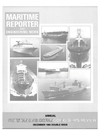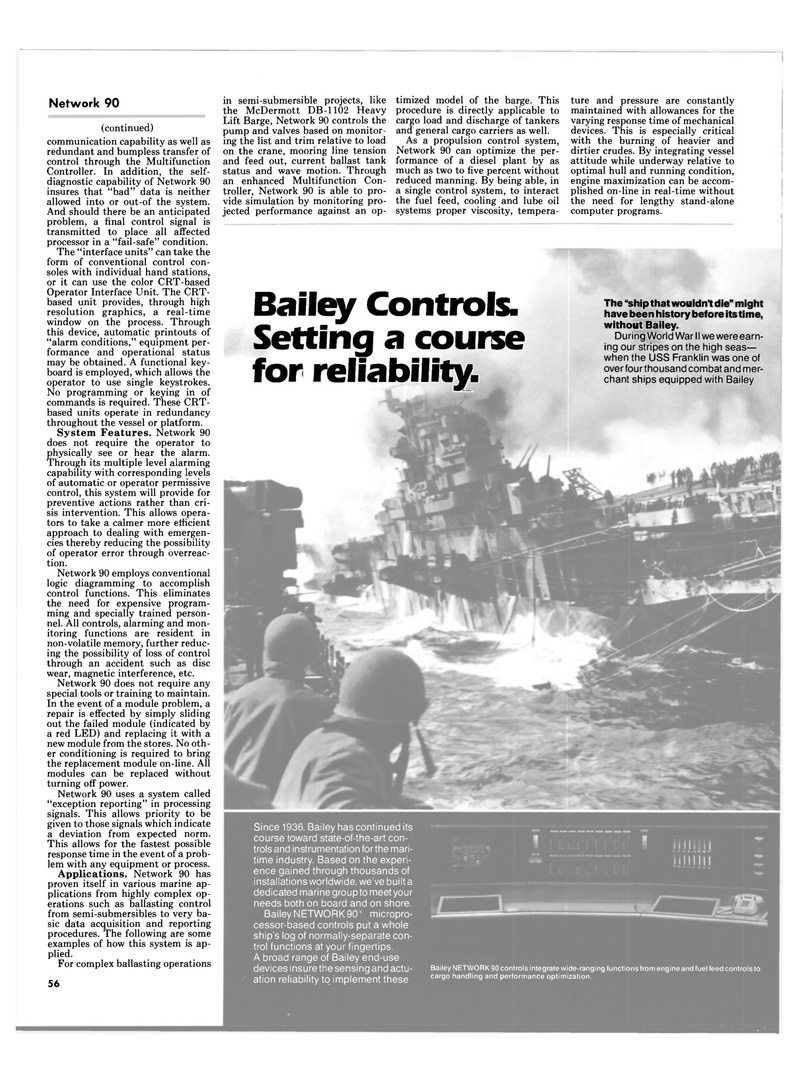
Page 56: of Maritime Reporter Magazine (December 1985)
Read this page in Pdf, Flash or Html5 edition of December 1985 Maritime Reporter Magazine
Network 90 (continued) communication capability as well as redundant and bumpless transfer of control through the Multifunction
Controller. In addition, the self- diagnostic capability of Network 90 insures that "bad" data is neither allowed into or out-of the system.
And should there be an anticipated problem, a final control signal is transmitted to place all affected processor in a "fail-safe" condition.
The "interface units" can take the form of conventional control con- soles with individual hand stations, or it can use the color CRT-based
Operator Interface Unit. The CRT- based unit provides, through high resolution graphics, a real-time window on the process. Through this device, automatic printouts of "alarm conditions," equipment per- formance and operational status may be obtained. A functional key- board is employed, which allows the operator to use single keystrokes.
No programming or keying in of commands is required. These CRT- based units operate in redundancy throughout the vessel or platform.
System Features. Network 90 does not require the operator to physically see or hear the alarm.
Through its multiple level alarming capability with corresponding levels of automatic or operator permissive control, this system will provide for preventive actions rather than cri- sis intervention. This allows opera- tors to take a calmer more efficient approach to dealing with emergen- cies thereby reducing the possibility of operator error through overreac- tion.
Network 90 employs conventional logic diagramming to accomplish control functions. This eliminates the need for expensive program- ming and specially trained person- nel. All controls, alarming and mon- itoring functions are resident in non-volatile memory, further reduc- ing the possibility of loss of control through an accident such as disc wear, magnetic interference, etc.
Network 90 does not require any special tools or training to maintain.
In the event of a module problem, a repair is effected by simply sliding out the failed module (indicated by a red LED) and replacing it with a new module from the stores. No oth- er conditioning is required to bring the replacement module on-line. All modules can be replaced without turning off power.
Network 90 uses a system called "exception reporting" in processing signals. This allows priority to be given to those signals which indicate a deviation from expected norm.
This allows for the fastest possible response time in the event of a prob- lem with any equipment or process.
Applications. Network 90 has proven itself in various marine ap- plications from highly complex op- erations such as ballasting control from semi-submersibles to very ba- sic data acquisition and reporting procedures. The following are some examples of how this system is ap- plied.
For complex ballasting operations 56 in semi-submersible projects, like the McDermott DB-1102 Heavy
Lift Barge, Network 90 controls the pump and valves based on monitor- ing the list and trim relative to load on the crane, mooring line tension and feed out, current ballast tank status and wave motion. Through an enhanced Multifunction Con- troller, Network 90 is able to pro- vide simulation by monitoring pro- jected performance against an op- timized model of the barge. This procedure is directly applicable to cargo load and discharge of tankers and general cargo carriers as well.
As a propulsion control system,
Network 90 can optimize the per- formance of a diesel plant by as much as two to five percent without reduced manning. By being able, in a single control system, to interact the fuel feed, cooling and lube oil systems proper viscosity, tempera- ture and pressure are constantly maintained with allowances for the varying response time of mechanical devices. This is especially critical with the burning of heavier and dirtier crudes. By integrating vessel attitude while underway relative to optimal hull and running condition, engine maximization can be accom- plished on-line in real-time without the need for lengthy stand-alone computer programs.
Since 1936, Bailey has continued its course toward state-of-the-art con- trols and instrumentation for the mari- time industry. Based on the experi- ence gained through thousands of installations worldwide, we've built a dedicated marine group to meet your needs both on board and on shore.
Bailey NETWORK 90' micropro- cessor-based controls put a whole ship's log of normally-separate con- trol functions at your fingertips.
A broad range of Bailey end-use devices insure the sensing and actu- ation reliability to implement these
Bailey NETWORK 90 controls integrate wide-ranging functions from engine and fuel feed controls to cargo handling and performance optimization.
The "ship that wouldn't die" might have been history before its time, without Bailey.
During World War 11 we were earn- ing our stripes on the high seas— when the USS Franklin was one of over four thousand combat and mer- chant ships equipped with Bailey
Bailey Controls.
Setting a course for reliability.

 55
55

 57
57
